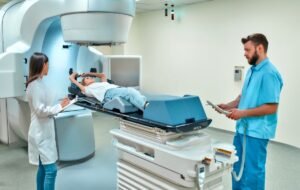
Treatment of cancer with radiation oncotherapy
As the name implies, radiation oncology is the use of high-energy radiation for the treatment of cancer. Over the years, radiation therapy has become an essential part of cancer treatment, helping to alleviate symptoms, shrink tumors, and prevent cancer from spreading. With the advancement of technology, radiation oncology has become even more effective, offering patients a range of state-of-the-art techniques for treating cancer.
Precision is one of the key benefits of radiation therapy. Radiation oncologists use sophisticated imaging techniques, such as CT scans and MRIs, to map cancer cells accurately. Using this information, radiation is delivered precisely to the cancer site, minimizing damage to healthy tissue and reducing side effects.
Another advantage of radiation therapy is its versatility. Radiation can be delivered externally, using a machine that is positioned outside the body, or internally, using a radioactive source that is placed directly into the body. This allows radiation oncologists to choose the best treatment option for each patient, based on the type and location of cancer, as well as the patient’s overall health.
It is also possible to use radiation therapy i
n combination with other treatments, such as surgery and chemotherapy, to increase the chances of success. An example of radiation use would be shrinking a tumor before surgery to facilitate removal, or following surgery to prevent cancer from returning.
One of the latest advancements in radiation oncology is image-guided radiation therapy (IGRT). IGRT uses real-time imaging to track the movement of tumors and adjust the radiation beam accordingly. This allows for even greater precision in the delivery of radiation, reducing the risk of damage to healthy tissue and increasing the chances of success.
Intensity-modulated radiation therapy (IMRT) is another state-of-the-art radiation therapy technique. Radiation can be delivered more precisely with IMRT by delivering multiple beams at various intensities, controlled by a computer. In particular, this treatment is effective in treating cancers that are located near sensitive organs, such as the prostate and the head and neck.
Despite the many benefits of radiation therapy, there are still some challenges that must be overcome. One of the biggest challenges is the risk of side effects, which can include fatigue, skin irritation, and nausea. However, with the advancement of technology and the use of newer techniques, such as IGRT and IMRT, the risk of side effects has been greatly reduced.
In conclusion, radiation oncology is a critical component of cancer treatment, offering patients a range of state-of-the-art techniques for treating the disease. With the use of sophisticated imaging and the advancement of technology, radiation therapy has become even more precise and effective, helping to alleviate symptoms, shrink tumors, and prevent cancer from spreading. Despite the challenges that remain, radiation oncology is an essential part of the fight against cancer, offering hope and improved outcomes to patients around the world.

